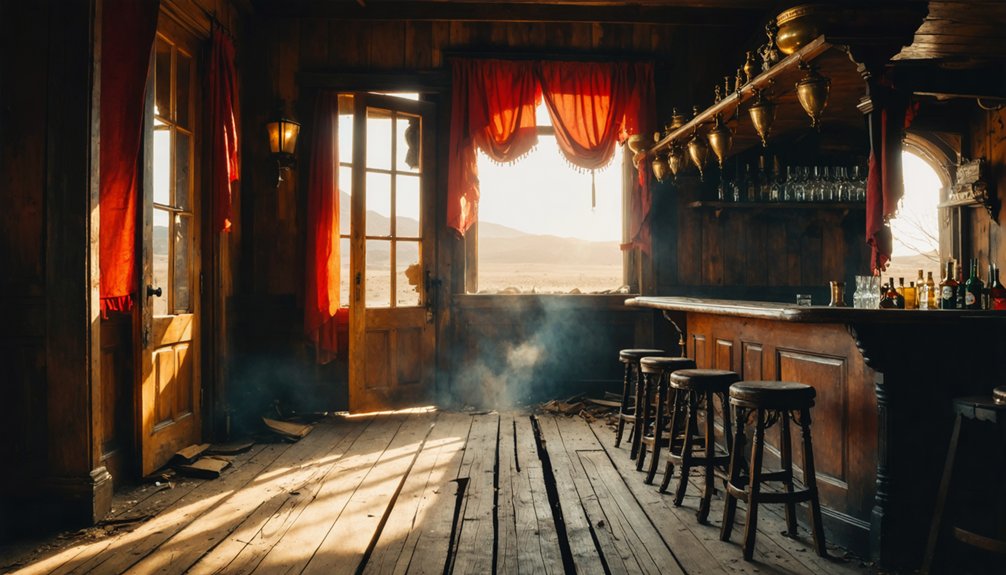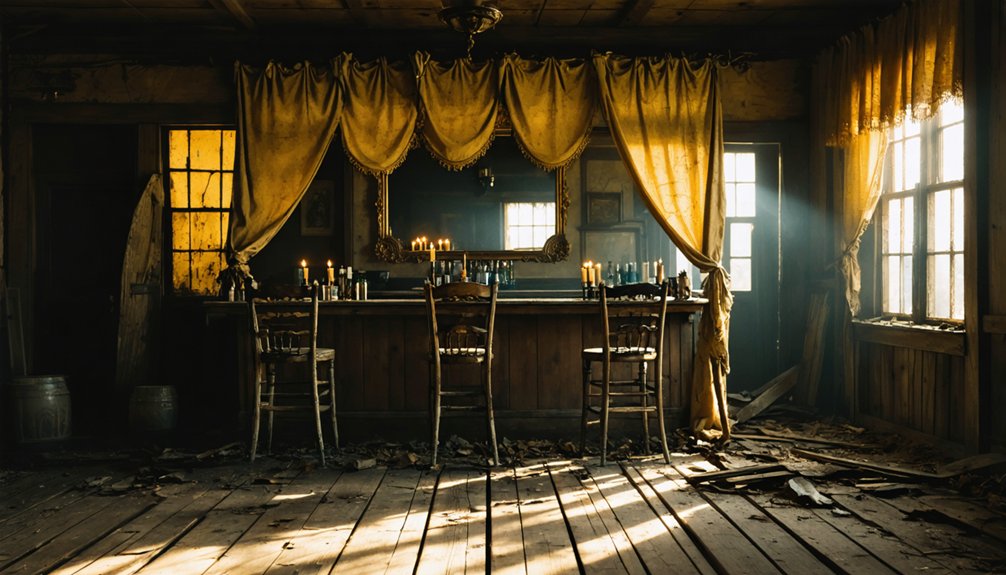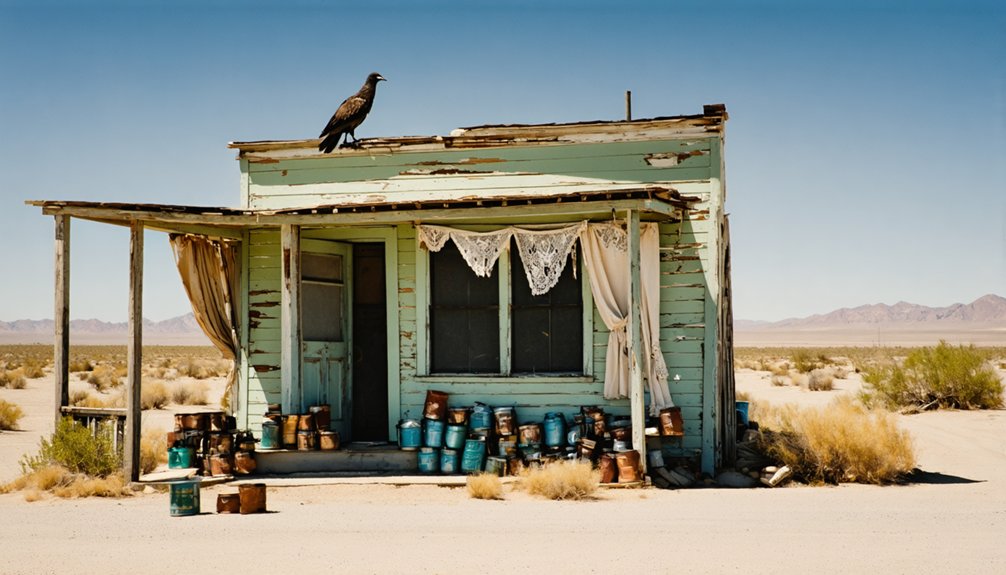Midway emerged as a mining settlement in California’s Mojave Desert during the 1880s, positioned strategically between major mining camps. You’ll find scattered ruins of this forgotten community, including weathered wooden structures and rusted machinery that once supported gold and silver extraction. The town declined when mineral veins dried up and transportation routes shifted elsewhere. Visit during spring or fall for the best photography conditions. Midway’s compelling mystery lies in its striking absence from historical records.
Key Takeaways
- Midway was established in the 1880s in California’s Mojave Desert as a mining settlement between major camps.
- The town declined when gold and silver veins depleted, transportation routes shifted, and mining methods became obsolete.
- Visitors can explore abandoned structures, rusted mining machinery, and stone foundations that outline the town’s past.
- Located 68 miles northwest of Victorville in Kern County, best visited during spring or fall.
- Historical documentation about Midway is limited, with significant gaps in California’s ghost town records.
The Lost Mining Settlement of Midway: Historical Origins
Tucked away in the vast expanse of the Mojave Desert, Midway emerged as a modest mining settlement in the 1880s, drawing hopeful prospectors who’d heard whispers of gold and silver hidden in the surrounding hills.
You’ll find that Midway earned its name from its strategic position between major mining camps and supply hubs, offering a practical base for those seeking fortune.
As mining techniques evolved from simple panning to more complex extraction methods, the community dynamics shifted from transient prospectors to established families. The town experienced a familiar pattern of boom and bust that characterized many California ghost towns of the era.
The town gradually developed essential structures—a post office, general store, and rudimentary housing—creating a frontier outpost where freedom and opportunity beckoned those willing to endure the harsh desert conditions. Much like Calico, Midway’s landscape was characterized by colorful mineral-stained mountains that served as natural landmarks for travelers.
Gold Rush Connections: Midway’s Place in California Mining History
While California’s iconic Gold Rush began in 1848 at Sutter’s Mill nearly 500 miles to the north, Midway carved its own distinct chapter in the state’s mining narrative during the latter waves of mineral exploration.
Midway’s geology shared characteristics with Southern California deposits, which yielded modest but valuable finds compared to the Mother Lode region.
You’ll find Midway’s operations followed the evolution from individual placer mining to organized hard-rock extraction, with miners employing techniques like coyoteing and amalgamation with mercury. The transition to these more complex methods mirrored the broader industry shift to hydraulic mining that caused widespread environmental damage. Similar to how James Marshall discovered gold while inspecting a sawmill in 1848, many Midway discoveries occurred during routine construction and development.
Ghost town legends tell of claim-jumping disputes and miners who quickly abandoned sites seeking richer deposits.
Unlike northern operations that extracted over 370 tons of gold in the first five years, Midway’s significance stemmed from its contribution to the expanding mining frontier that ultimately produced $25 billion in gold.
Life in Boom Times: Social Structure of Early Midway

During the height of Midway’s mining boom, a distinct social hierarchy emerged that mirrored many frontier communities while developing its own unique characteristics.
You’d find mining entrepreneurs and claim owners at the top, controlling wealth and directing the town’s economic activity. Skilled miners, merchants, and shopkeepers formed a significant middle tier that kept the community functioning. Unlike San Jose which was established as the first civilian settlement in California, Midway developed primarily around mining interests rather than agricultural needs.
Service workers—saloon keepers, cooks, and general laborers—maintained daily life’s rhythms. At the bottom were transient miners without permanent claims, moving between camps as fortunes dictated.
Community dynamics centered around gathering spots like saloons and communal halls, where social roles intersected and information flowed freely. Unlike the indigenous communities, these settlers had minimal interest in the acorn flour that had sustained California’s native populations for millennia.
While mainly populated by young single men, Midway’s diverse immigrant population contributed varying cultural influences, with women and families playing essential supporting roles despite their smaller numbers.
The Decline Era: Why Midway Became a Ghost Town
As Midway’s golden era came to an end in the late 19th century, the once-thriving mining community began its inexorable descent into abandonment.
You’d have witnessed the economic isolation first-hand as gold and silver veins ran dry, forcing mines to close and workers to seek opportunities elsewhere.
Midway’s mining legacy couldn’t sustain the town when transportation routes shifted, bypassing the settlement entirely.
New railroads redirected commerce and travelers, severing crucial economic lifelines.
Environmental challenges compounded these problems—contaminated water and degraded land made sustainable living increasingly difficult.
Technological advancements rendered traditional mining methods obsolete, while younger residents departed for urban centers with promising futures.
Much like at Bodie State Historic Park, Midway exemplifies the boom and bust cycle that defined many California mining settlements during this period.
One by one, schools closed, saloons shuttered, and postal services disappeared, leaving behind only echoes of the vibrant community that once thrived.
Structures were gradually stripped of resources and abandoned, leaving them vulnerable to natural decay and vandalism, a common fate shared by most California ghost towns.
What Remains Today: Physical Landmarks and Structures
When you visit Midway today, you’ll find rusted mining machinery scattered across the landscape, including ore carts and pulley systems that once facilitated the town’s economic lifeblood.
The wooden structures that remain stand in various states of decay, with weathered clapboard storefronts leaning precariously and partial roofs offering glimpses into the past through their skeletal frameworks. Many visitors enjoy exploring these buildings similar to the preserved structures in hydraulic mining towns like Malakoff Diggins.
Stone foundations outline where buildings once stood completely, creating a ghostly footprint that allows visitors to mentally reconstruct the bustling mining community that thrived here before abandonment. Similar to Bodie Historic State Park, Midway allows visitors to walk through its deserted streets and imagine the once-thriving town during the gold rush era.
Abandoned Mining Equipment
The rusting skeletons of Midway’s mining heritage still cling to the hillsides, silent witnesses to the town’s boom-and-bust story. While specific documentation of Midway’s remains is limited in historical records, the area likely follows patterns seen in similar California ghost towns.
If you visit, you might find abandoned machinery partially reclaimed by nature—ore carts derailed decades ago, their metal frames oxidized by countless seasons.
Mining relics such as stamp mill foundations, headframes, and cable systems may dot the landscape, though their condition varies widely depending on scavenging and weathering.
Local historical societies would be your best resource for accurate information about Midway’s specific equipment remains, as each mining community left behind unique industrial footprints reflecting their particular extraction methods and the era’s technology.
Deteriorating Wooden Structures
Beyond the industrial remains, Midway’s wooden structures tell an equally compelling story of abandonment and time’s relentless march.
Walking through sagging doorframes, you’ll witness deterioration patterns that reveal how harsh California seasons have transformed once-vibrant community spaces. The Methodist church stands resilient despite its weathered exterior, while nearby storefronts display structural decay through cracked window frames and peeling paint.
What you’ll discover inside these fragile time capsules:
- Original period furnishings frozen in domestic arrangements, with pink wallpaper still clinging to what was likely a child’s bedroom
- The saloon’s wooden bar counter with dusty bottles lined precisely as they were left decades ago
- Wooden floorboards warping under the pressure of plant life reclaiming its territory, creating natural archways through doorways
Historic Foundation Remnants
Sturdy foundation remnants across Midway’s landscape offer visitors perhaps the most authentic window into the town’s original footprint and scope. As you explore the site, you’ll notice stone and brick outlines marking where saloons, stores, and homes once stood—silent testimony to the community that thrived here.
Recent foundation archaeology projects have uncovered previously hidden structural remnants, revealing construction techniques typical of 1880s California mining settlements. These excavated footings provide essential information about building dimensions and town planning that wouldn’t be discernible otherwise.
Many foundation stones retain original chisel marks from local stonemasons. Unlike deteriorated wooden structures, these foundation patterns have withstood both time and weather, offering you an opportunity to mentally reconstruct Midway’s heyday by walking its original thoroughfares and community spaces.
Visiting Midway: Practical Information for Explorers

Planning your expedition to Midway requires careful preparation, as this remote ghost town offers an authentic glimpse into California’s mining past without modern conveniences.
Located in Kern County’s Mojave Desert region, you’ll find Midway about 68 miles northwest of Victorville, accessible via State Route 14.
- Best timing – Visit during spring or fall to avoid summer’s punishing 100°F+ temperatures or winter’s limited daylight hours.
- Essential exploration tips – Bring ample water, sun protection, and emergency supplies; cell reception is unreliable.
- Visitor safety priorities – Watch for wildlife like snakes and scorpions, respect private property, and always inform someone of your travel plans.
No entry fees or permits are required, but you won’t find facilities here—plan accordingly.
Midway’s Regional Context: Neighboring Ghost Towns
When you explore Midway, you’ll discover its essential position within the Sierra Nevada’s interconnected mining district, where prospectors and freight services once traveled along established routes linking now-abandoned towns like Bodie and Chinese Camp.
Your journey traces the same paths where stagecoaches and supply wagons connected these settlements through a complex transportation network that facilitated the region’s brief economic boom.
Midway’s abandonment mirrors the shared fate of neighboring communities whose prosperity vanished as mineral deposits depleted, creating the constellation of ghost towns that now dots California’s historic gold country.
Mining District Connections
The Paymaster Mining District, with Midway at its heart, formed an essential node within Imperial County‘s network of mineral wealth since at least 1867.
While exploring this area, you’ll discover mining claims stretching from Midway Well to Quartz Peak and the productive Blackhawk Mine, all following similar geological trends of gold-bearing quartz veins and complex ore bodies.
Three key connections that linked Midway to regional mining prosperity:
- Shared water resources – Midway Well served multiple operations in this arid landscape
- Interconnected transportation via the historic Bradshaw Trail
- Economic interdependence through complementary mineral production (gold, silver, tungsten)
The district’s mines responded collectively to market fluctuations, with wartime demand for tungsten shifting focus from precious metals to industrial minerals throughout the early 20th century.
Transportation Route Network
Situated at a critical junction of desert travel routes, Midway formed an essential link in the transportation network that connected California’s southeastern mining communities during the late 19th and early 20th centuries.
When you travel this region today, you’re traversing the same corridors that once buzzed with stagecoaches and freight wagons hauling precious ore and supplies.
Midway’s strategic position in transportation history gave it outsized significance despite its modest size. The town served as a vital waypoint between larger settlements, offering weary travelers respite before continuing their arduous journeys across the harsh desert landscape.
Though Midway itself has faded into obscurity, the route significance remains embedded in the region’s tapestry, with modern highways often following these historic pathways that once determined which communities thrived and which were abandoned.
Midway’s story mirrors that of countless settlements across California’s mining region, where prosperity proved as fleeting as the precious metals that birthed them.
The area’s economic vulnerabilities became painfully evident as:
- Silver market crashes in the 1890s devastated neighboring Calico and triggered regional decline
- One-industry towns lacked diversification to weather commodity price fluctuations
- Widespread population shifts occurred as miners and merchants simultaneously abandoned multiple towns
You’ll find this pattern repeated throughout the region, where communities faced identical challenges.
When mines closed, commercial activities evaporated shortly after.
While some neighbors like Calico eventually reinvented themselves through tourism and heritage preservation, most settlements—including Midway—lacked the resources or geographic advantages to adapt successfully, leaving behind clusters of ghost towns that collectively tell the story of regional economic collapse.
Preservation Efforts and Historical Documentation
While searching for information on Midway’s preservation efforts, historians and local enthusiasts have encountered significant documentation gaps in California’s ghost town records.
Unlike well-documented sites like Calico or Cerro Gordo, Midway’s status as a ghost town remains unconfirmed in available research materials.
While celebrated ghost towns boast extensive records, Midway exists only in historical shadows, its very existence as an abandoned settlement unverified.
This absence in historical catalogs presents both a challenge and opportunity for preservationists interested in California’s abandoned settlements.
Without verified historical artifacts or established preservation methods specific to Midway, researchers must exercise caution when including it among California’s authentic ghost towns.
Community researchers should investigate whether Midway truly qualifies as a ghost town before developing preservation initiatives.
If you’re exploring California’s forgotten places, consider focusing on verified ghost towns with established historical documentation while contributing to efforts that might eventually uncover Midway’s true historical status.
Legends and Folklore: Tales From Midway’s Past

Unlike many documented ghost towns that feature rich oral traditions, legends surrounding the purported Midway settlement remain conspicuously absent from California’s historical record. This curious void in folklore stands in stark contrast to well-documented ghost towns like Bodie or Calico, where ghostly encounters and local legends abound.
- The silence itself has become Midway’s most compelling mystery, prompting history enthusiasts to question whether significant oral traditions were lost as original settlers dispersed.
- Your exploration of Midway connects you to this historical enigma, inviting personal interpretation of the settlement’s abandoned structures.
- Communities surrounding former ghost towns often preserve their stories through generational storytelling, yet Midway’s narrative remains elusive, waiting for dedicated historical research to uncover its forgotten voices.
Photography Guide: Capturing Midway’s Haunting Beauty
The haunting beauty of California’s forgotten settlement offers photographers an unparalleled canvas for creative expression.
Arm yourself with wide-angle lenses (16-35mm) for expansive townscapes and fast primes for night photography. Tilt-shift lenses will correct perspective distortion in your architectural shots.
Visit during golden hour when the sun bathes Main Street’s weathered buildings in warm light. For dramatic ghost town aesthetics, shoot during blue hour or try light painting techniques after dark to highlight architectural features.
Compose your frames through doorways and windows for layered storytelling images. Capture textures of peeling paint and rusted metal with close-ups, then convert to black and white to enhance mood.
Remember to pack extra batteries—Midway’s photographic treasures demand extended shooting sessions as you document our community’s forgotten past.
Frequently Asked Questions
Was Midway Connected to Any Famous Outlaws or Sheriffs?
Like sifting for ghost gold, your search for outlaw legends or sheriff tales in Midway comes up empty. No historical records connect this railroad transit point with any famous lawmen or criminals.
Did Midway Have Any Natural Disasters That Contributed to Abandonment?
No documented earthquake impacts or flood damage contributed to Midway’s abandonment. You’ll find its decline more likely stemmed from economic factors typical of mining communities rather than natural disasters.
Were Any Films or Television Shows Shot in Midway?
Like a VHS rewind, there’s no documented evidence of film locations or television series utilizing Midway. You won’t find cameras rolling through this ghost town’s weathered remains, despite California’s rich filming history.
What Indigenous Tribes Occupied the Area Before Midway’s Establishment?
You’d find the Coast Miwok, Patwin, Pomo, and Wappo tribes inhabited the area, maintaining deep cultural significance through sustainable practices and village communities like Huchi before Midway’s tribal history was disrupted.
Did Any Notable Inventions or Technologies Originate in Midway?
You won’t find notable Midway inventions or technologies originating there. The town adopted common mining practices like hydraulic techniques, dynamite usage, and ore processing rather than pioneering unique technological developments.
References
- https://www.vvdailypress.com/story/lifestyle/travel/2024/02/21/what-you-need-to-know-when-you-visit-kern-county-ghost-town-randsburg/72629893007/
- https://main.sbcounty.gov/2025/05/29/san-bernardino-county-history-calico-ghost-town/
- https://rachelsruminations.com/favorite-ghost-towns-in-california/
- https://www.visitcalifornia.com/road-trips/ghost-towns/
- https://en.wikipedia.org/wiki/List_of_ghost_towns_in_California
- http://freepages.rootsweb.com/~gtusa/history/usa/ca.htm
- https://www.hauntedplaces.org/midway-city-ca/
- https://www.islands.com/1945433/california-famous-ghost-town-calico-wild-west-tourist-trap-once-thriving-boom-mining/
- https://www.findmall.com/threads/california-ghost-towns.251191/
- https://la.curbed.com/2018/2/13/16968220/ghost-towns-desert-california-city-calico



